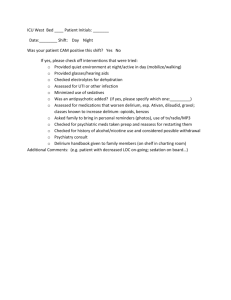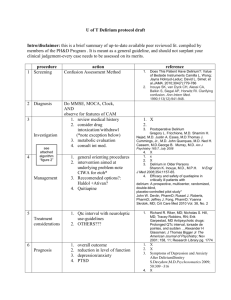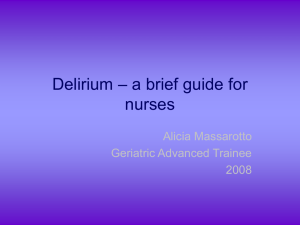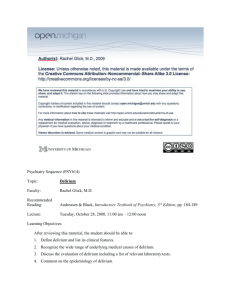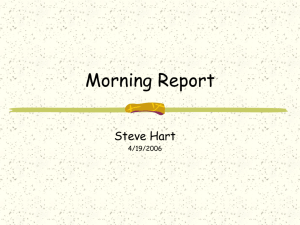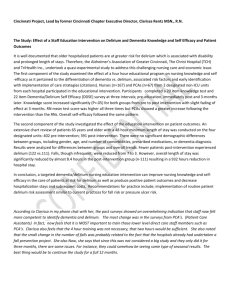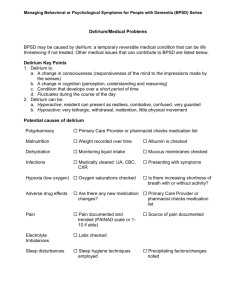Delirium - Palliative.info
advertisement
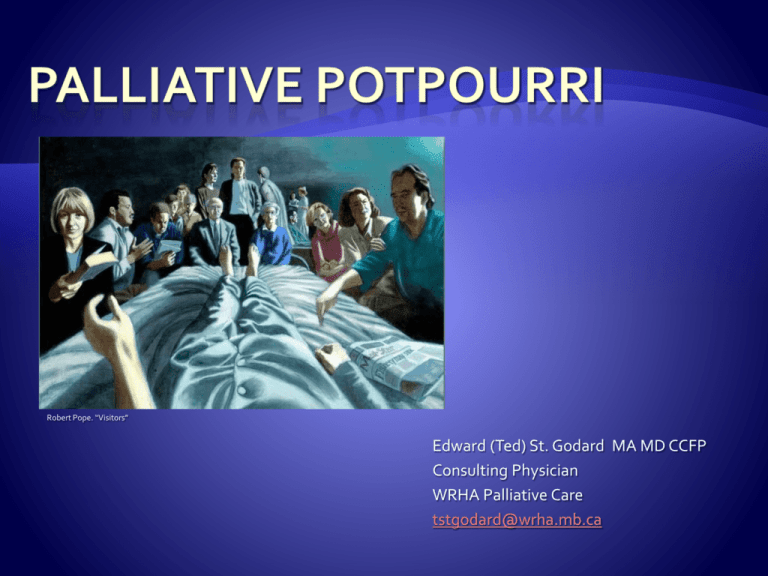
Robert Pope. “Visitors” Edward (Ted) St. Godard MA MD CCFP Consulting Physician WRHA Palliative Care tstgodard@wrha.mb.ca I am funded as an independent contractor by the WRHA At the end of session, participants will Be able to identify the medical condition known as delirium; Appreciate the importance of this recognition; Have an approach to delirium management Nurses are in an optimal position to detect fluctuating symptoms of delirium Agar et al. Palliative Medicine. September, 2011. Silent, unspoken piece of nursing practice, impacting on workload Nurses deal with the unpredictable and fluctuating condition of delirious patients, which may be a signal of impending ‘chaos’ Agar et al. Palliative Medicine. September, 2011. Under-detection of delirium relates to a lack of knowledge of the criteria for identifying delirium… failure to relay or communicate detected symptoms at onset… Agar et al. Palliative Medicine. September, 2011. Global cerebral dysfunction “Brain Failure” Early signs often mistaken as anger, anxiety, depression, psychosis A) Change in consciousness with reduced ability to focus, sustain or shift attention B) Change in cognition (e.g., memory, disorientation, change in language, perceptual disturbance) that is not dementia C) Abrupt onset (hours to days) with fluctuation D) Evidence of medical condition judged to be etiologically related to disturbance …a disturbance in consciousness with inattention and problems in cognition and/or a disturbance in perception that develop over hours to days with organic causes. Delirium Dementia Impaired memory Impaired memory Impaired judgement Impaired judgement Impaired thinking Impaired thinking Disorientation Disorientation Delirium Dementia Abrupt onset Insidious, progressive Decreased LOC Alert, LOC intact Sleep/wake cycle Minimal Delirium Dementia Reversible? Irreversible PREVENTABLE? In up to 50 % of patients with advanced cancer, delirium can be reversed Kang JH et al. “Comprehensive approaches to managing delirium in patients with advanced cancer.” Cancer Treat Rev (2012) 60 40 20 Rev Non Rev 0 Hypoxia Infect Metabol Other Dehyd Opioids Lawlor P, Gagnon B, Mancini I, Pereira J, et al. Arch Intern Med 2000 Hypoactive confusion, somnolence, alertness Hyperactive agitation, hallucinations, aggression Mixed (>60%) features of both Lawlor P, Gagnon B, Mancini I, Pereira J, et al. Arch Intern Med 2000 80 % in medical intensive care units (ICU) 28 % in patients following hip fracture 22 % in general medical inpatients Partridge et al. “The delirium experience: what is the effect on patients, relatives and staff and what can be done to modify this?” Int J Ger Psych. October 2012 (online) Most frequent neuropsychiatric complication in patients with advanced CA Up to 85 % of patients delirious prior to death Bruera et al. JPSM 2010; 39;2: 186-196 ~ 42% patients in PC program delirious on admission 50% of episodes reversible “Terminal delirium” in 88 % Lawlor et al. Arch Intern Med 2000; 160:786 Delirium/terminal restlessness (55%) Dyspnea (27%) Pain (18%) Nausea/vomiting (4%) Eisenchlas. Current Opinion in Supportive and Palliative Care 2007, 1:207–212 Delirium number one reason for requests Fainsinger RL et al. “A multicentre international study of sedation for uncontrolled symptoms in terminally ill patients.” Palliat Med 2000;14:257– 65. “We’d rather see dad dead than like this.” “S/he would be horrified by this.” 73/99 patients (74%) remembered delirious episode Of these, 81 % recalled experience as distressing Family stress > patients’ recalled stress Bruera et al. JPSM 2010; 39;2: 186-196 Interferes with Sx assessment and Tx Increases morbidity and mortality Hinders communication within families Bruera et al. JPSM 2010; 39;2: 186-196 D/D Pain Dyspnea Delirium Ax/Tx Challenges Worsening Delirium Delirium mediated by failure in central cholinergic transmission? Acetylcholine final common neurotransmitter pathway leading to delirium? White et. al. “First Do no Harm…” JPM. 10 (2); 2007: 345-351 Relative acetylcholine deficiency and dopamine excess could mediate the characteristic symptoms of delirium Delirium can be evoked by dopamine agonists and anticholinergic medications Moyer. American Journal of Hospice and Palliative Medicine 28(1), 2011. 44- 51 Kang JH et al. Comprehensive approaches to managing delirium in patients with advanced cancer. Cancer Treat Rev (2012) Dopamine/acetylcholine inverse relationship Haloperidol first line treatment for delirium Haloperidol D2 antagonist: ? Haloperidol increase levels acetylcholine? White et. al. “First Do no Harm…” JPM. 10 (2); 2007: 345-351 Kang JH et al. Comprehensive approaches to managing delirium in patients with advanced cancer. Cancer Treat Rev (2012) Sometimes successfully treated with dopamine receptor antagonists and possibly by cholinesterase inhibitors High serum anticholinergic activity in patients with delirium Moyer. American Journal of Hospice and Palliative Medicine 28(1), 2011. 44- 51 Υ-aminobutyric acid (GABA)-ergic benzodiazepines seem to cause delirium Neuroinflammatory processes drives upregulation of GABA receptors GABA receptor versus microglial activation versus apoptosis C.G. Hughes et al. “Future Directions in Delirium Management and Research.” Best Practice & Research Clinical Anaesthesiology. 26 (2012) 395–405 Predisposing Precipitating Predisposing factors: Prevalence increases with age Male > female Visual impairment Depression White et. al. “First Do no Harm…” JPM. 10 (2); 2007: 345-351 Predisposing factors: Functional dependence Immobility Hip fracture Dehydration Alcoholism Stroke Severity of physical illness White et. al. “First Do no Harm…” JPM. 10 (2); 2007: 345-351 All of our patients! Inverse relationship between the preexisting vulnerability of the patient, and the severity of the insult necessary to precipitate delirium Most patients nearing EOL have multiple predisposing factors Most of these are beyond our control Predisposing Precipitating Impractical, given our patient population (frail, usually old) Imperative to minimize precipitating factors ‘lyte derangements (dehyd’n, hypo/hypernatremia) Infx (UTI, resp., skin/soft tissue [sacral ulcers]) Metabolic (hyper/hypoglycemia, hypercalcemia, uremia) Low perfusion, hypoxia Withdrawal • • • • • Anti-cholinergics (Gravol, TCAs, anti-secretories); BZDs Opioids Steroids Cipro, lasix (?) ranitidine, and on and on…. Drug withdrawal: EtOH, Bzd, opioid, “street drugs” Prophylactic haldol Prophylactic olanzepine Prohylactic cholinesterase inhib.s Gagnon et al. Psycho‐Oncology 21: 187–194 (2012) Maintain sensorium: hearing aids, eye glasses Orientation (clocks, calendars, conversation) Gagnon et al. Psycho‐Oncology 21: 187–194 (2012) No good evidence for benefit from screening hospitalized patients Greer N et al. Delirium: screening, prevention, and diagnosis – a systematic review of the evidence 2011 Internet. “Cured yesterday of her disease, she died last night of her doctor.” paraphrasing Jonathon Swift (you know, Gulliver’s Travels) Medication sole precipitant of delirium in 12 – 39 % healthy patients Alagiakrishnan et al. Postgrad Med J, 2004; 88: 388-393 Drug toxicity, drug withdrawal Start low, go slow Very often, less is more Analgesics: Uncontrolled pain is risk factor for delirium “Rome wasn’t built in a day” Balance pain against dose Titrate gently Analgesics: Titrate gently Don’t be afraid to decrease Ax/Tx Challenges Worsening Delirium Sedatives: “A benzodiazepine will never help your thinking.” Dr. Mike Harlos Lorazepam is an independent risk factor for delirium, increasing risk by ~ 20 % (not to mention falls, etc.) Panpharpande et al. Anesthesiology. 2006; 104:21 Kang JH et al. Comprehensive approaches to managing delirium in patients with advanced cancer. Cancer Treat Rev (2012) Sedatives: Try not to be the one who starts bzd, but don’t be the one who abruptly stops it Better a tired patient in AM than a delirious patient in AM “Anxiety,” “restlessness?” -- how about company? Going for a walk-about? More staff, fewer sedatives, less delirium? Drugs cheap, one-on-one expensive Value? Does vigorous hydration decrease delirium incidence? Hyd’n reversed or improved 30 – 70 % delirium cases Thomson et al. Current Op Supp Pal Care. 2009; 3:72-78 Name it Claim it Tame it “A little fluffy” “Loopy” “A little off” “Not quite right” “Fruit-cake” MMSE? CAM? Intuition? Do something; Name it…. Change in consciousness with reduced ability to focus, sustain or shift attention Engage in conversation? Months of year backward? Clinical suspicion Drs. cause delirium? Can Drs/nurses prevent it, reverse it, or reduce its impact? Who better? Two simultaneous pathways Seek and treat cause (thus reverse?) Manage behaviours (“supportive care”) Human intervention better than pharmacological Supportive measures Hydrate? Avoid restraints Mobilize Reduce noise, etc. Orient Reassure One-on-one Investigations MEDICATION REVIEW Bloodwork U/A Imaging Meds: Eliminate any psychoactive med possible: Metoclopramide, cipro? Baclofen? Ranitidine? Lasix? others? Meds: Analgesia: Good pain control? Consider dose reduction? Sub-optimal pain control? Opioid rotation IF investigations reveal pathology that can reasonably be thought to be causing delirium; AND IF the pathology can be treated; AND IF it is in keeping with goals of care; trial treatment Does patient behaviour compromise care, or put patient, staff, or others at risk? If “yes,” can a bedside sitter safely help? If “no,” low-dose neuroleptic and/or lowdose bzd Haloperidol remains standard of care Powerful Oral and parenteral Limited anti-cholinergic, sedative properties White et. al. “First Do no Harm…” JPM. 10 (2); 2007: 345-351 No significant differences in response in double-blind RCT comparing risperidone and haloperidol Similar evidence finding minimal differences in efficacy between olanzapine and risperidone Bourne et. al. “Drug Treatment of Delirium.” Journal Psychosomatic Research. 65; 2008: 273 - 282 Kang JH et al. “Comprehensive approaches to managing delirium in patients with advanced cancer.” Cancer Treat Rev (2012) Methylphenidate can improve cognitive and psychomotor function in hypoactive delirium Methylphenidate can cause agitation, aggravation, psychosis Bourne et. al. “Drug Treatment of Delirium.” Journal Psychosomatic Research. 65; 2008: 273 - 282 Delirium is bad Hard on patients, families, staff Often preventable, often iatrogenic Nurses optimally located Occasionally reversible At the end of this session, you will Understand the importance of context in the interpretation of pain Appreciate at a basic level the physiology of pain and some principles of analgesia Have an approach to pain management that always bears in mind the above points 11/11 65 % 12/12 91 % Think about pain…. Palliative care is an approach that improves the quality of life of patients and their families facing the problem associated with life-threatening illness, through the prevention and relief of suffering by means of early identification and impeccable assessment and treatment of pain and other problems, physical, psychosocial and spiritual. the prevention and relief of suffering….. …by means of early identification and impeccable assessment and treatment of pain and other problems, physical, psychosocial and spiritual. Loeser, JD. “Perspectives on Pain.” Clinical Pharmacology and Therapeutics. Padgham, ed. Baltimore: University Park Press. 1980. p 314 Loeser, JD. “Perspectives on Pain.” Clinical Pharmacology and Therapeutics. Padgham, ed. Baltimore: University Park Press. 1980. p 314 Multi-disciplinary Team? Pain or Suffering? Both? Neither? “…an unpleasant sensory and emotional experience associated with actual or potential tissue damage or described in terms of such damage.” Merskey H, Bogduk N. 2nd ed Seattle, WA: IASP Press; 1994. “…what ever the experiencing person says it is, existing whenever s/he says it does.” Merskey H, Bogduk N. 2nd ed Seattle, WA: IASP Press; 1994. Pain confers a survival benefit; we are “hardwired” to experience it Asthenia Anorexia Pain Nausea Constipation Sedation/Confusion % Patients Dyspnea 0 10 20 30 40 50 60 70 80 Bruera 1992 “Why Do We Care?” Conference; Memorial Sloan-Kettering 90 Seow H et al. “Trajectory of performance status and symptom scores for patients with cancer during the last six months of life.” J Clin Oncol 2011; 29:1151. Nociceptive visceral superficial Neuropathic somatic deep neuralgic dysesthetic hyperalgesia bony Adapted from Jovey R, 2002 NOCICEPTORS • Sensory receptors • Preferentially sensitive to noxious stimuli (tissue damaging/threatening) • Chemical, thermal, mechanical SOMATIC PAIN • Nociceptive • Aching, often constant • Often worse with mvt • Well localized • Tender – bone & soft tissue – chest wall – post-surgery incision VISCERAL PAIN • • • • Constant or crampy Dull, aching Poorly localized Often referred – CA pancreas – Bowel obstruction – Infiltration/compression/distension Pain initiated or caused by primary lesion or dysfunction in the nervous system International Association for the Study of Pain NP DESCRIPTORS Burning, Itching, Shooting, Shocklike, Electric, Lancinating “Pins and needles,” tingling, numb NP DESCRIPTORS “Pins and needles,” tingling, numb Pharmacologic treatment Anticonvulsants – gabapentin, pregabalin TCAs (esp. if depression) NMDA receptor antagonists: ketamine, dextromethorphan, methadone Steroids Opioids Up to 90% of patients with cancer pain could have their pain alleviated by following the treatment guidelines of the WHO analgesic ladder Fitzgibbon et al. “Parenteral Ketamine as an Analgesic Adjuvant for Severe Pain.” J Pall. Med. 8(1) 2005 Adjuvant Rx may be added at any step Strong opioid + Step 2 Weak opioid + Step 1 Acetaminophen & NSAIDs Mild pain (0-3) Severe (7-10) Moderate (4-6) By the clock By the ladder Adjuvant Rx may be added at any step Strong opioid + Step 2 Weak opioid + Step 1 Acetaminophen & NSAIDs Mild pain (0-3) Severe (7-10) Moderate (4-6) By the clock By the ladder TOXIC Serum [ drug ] Therapeutic Sub-therapeutic Time TOXIC Serum [ drug ] Therapeutic Sub-therapeutic Time TOXIC Serum [ drug ] Therapeutic Sub-therapeutic 4 hours 4 hours Life in the Bloodstream Think about drug, dose, route Steady decline at home Accelerated deterioration begins, pain worsening, pt. admitted, medications changed Rapid decline due to illness progression with diminished reserves Family thinking what? Every family is the Addams family ??????? Too much medication Not enough…. “It’s all the morphine you’re giving her…..” Popular misconception held by families, lay public, and professionals “’By the way, palliative care shortens your life,’ [xxxx] suggested.” “Increasing overall opioid dosage was associated with improved survival compared with no change or decreasing overall dosage (mean survival 14.0 12.7 days versus 9.3 9.8 versus 9.1 11.4, days respectively, P 5 .01).” Azoulay et al. “Opioids, Survival, and Advanced Cancer in the Hospice Setting.” J Am Med Dir Assoc. Feb. 2011; 12: 129 -134 “Opioid usage, even at high dosages, had no effect on survival among advanced cancer patients in a hospice setting.” Azoulay et al. “Opioids, Survival, and Advanced Cancer in the Hospice Setting.” J Am Med Dir Assoc. Feb. 2011; 12: 129 -134 “Among patients with metastatic non– small-cell lung cancer…, As compared with patients receiving standard care, patients receiving early palliative care had less aggressive care at the end of life but longer survival.” Temel et al. “Early Palliative Care for Patients with Metastatic Non–Small-Cell Lung Cancer.” N Engl J Med. 2010; 363:733 -42 SUB-Q MORPHINE Bruera et al. J Pain Symptom Manage. 1990; 5:341-344 64 woman resents to ED with “severe” pain; Hydromorph Contin 24 mg PO bid; Hydromorphone IR 6 mg Q1H prn, taking “several” times daily; “Confused” per family Pain “everywhere”; Poor historian, “muddled,” family report fairly rapid escalation of opioids past 3-4/7; O/E: vitals unremarkable, dry MM, decreased BS R>L, no adventitia, normal HS. Very tender over R rib cage (without compressing), abdo benign, DTR unremarkable, no tremors or twitches; ACP “M”; B/W shows creatinine increased from previous, at 195, dry, corrected Calcium 2.5; U/A benign; CXR no obvious rib fractures; AXR abundant stool, no a/f levels, no free air Pain “everywhere” (pathophysiology?); Family report fairly rapid escalation of opioids past 3-4/7; Poor historian, “muddled”; Creatinine up Potentially fatal neuropsychiatric syndrome of: Cognitive dysfunction Delirium Hallucinations Myoclonus/seizures Hyperalgesia / allodynia Early recognition is critical Normal Renal Fcn Renal Insufficiency Osborne et al. “The Pharmacokinetics of morphine and morphine glucuronides in Kidney Failure.” Clin Pharmacol Ther 54:158-167, 1993 Opioid tolerance Mild myoclonus (eg. with sleeping) Delirium Opioids Increased Severe myoclonus Seizures, Death Hyperalgesia Agitation Misinterpreted as Pain Opioids Increased Misinterpreted as Disease-Related Pain Switch opioid (rotation) and/or reduce dose Hydrate Bzd prn? Not everyone has pain ; Treating pain with scheduled opioids is appropriate and safe; Avoid long-acting formulations; Watch out for pain that “doesn’t make sense,” as it might be warning you of OIN Pain and suffering are distinct, and not always related as closely as we think PAIN POSSIBLE Suffering? At the end of the session, you will • Have a basic understanding of respiration • Be aware of the complex mechanisms underlying dyspnea • Have an approach to the management of dyspneic patients “Subjective experience of breathing discomfort that consists of qualitatively distinct sensations that vary in intensity.” American Thoracic Society. “Dyspnea: Mechanisms, Assessment, and Management, a Consensus Statement.” Am J Respir Crit Care Med. 1999; 159: 321 - 340 DYSPNEA • Physical and emotional components (anxiety, panic, chronic fear) • Often no measurable physical correlates (RR ? SaO2 ? ABG) Tachypnea ≠ dyspnea Universal response is to decrease activity to whatever degree necessary Dudgeon, D. “Managing Dyspnea and Cough.” Hematology/Oncology Clinics of North America. 2002; 16: 557-577 A B C D “Subjective experience of breathing discomfort that consists of qualitatively distinct sensations that vary in intensity.” American Thoracic Society. “Dyspnea: Mechanisms, Assessment, and Management, a Consensus Statement.” Am J Respir Crit Care Med. 1999; 159: 321 - 340 Months Without eating Days Without drinking Minutes Without breathing • Dyspnea, like pain, is protective. As pain alerts us to actual or impending tissue damage, dyspnea alerts us to threat. • “Hardwired” to protect • 60 % lung Ca patients • Nearly 90 % once near death • 50 % described dyspnea as severe Muers MF, Round CE. “Palliation of symptoms in non-small cell lung cancer: a study by the Yorkshire Regional Cancer Organization thoracic group.” Thorax 1993;48:339– 43. Reuben DB, Mor V. “Dyspnea in terminally ill cancer patients.” Chest. 1986; 89(2): 234-6. • Abnormality of blood gases, especially hypercapnia (PaCO2 > 50 mmHg) and, to a lesser extent, hypoxia (PaO2 < 60 mmHg); • Amount of work that must be performed by respiratory muscles to provide adequate ventilation; • State of mind. Guyton and Hall. Textbook of Medical Physiology. 491 Mahler. “Understanding Mechanisms …Dyspnea.” Current Opinion in Supportive and Palliative Care .2011, 5:71–76 • Integrates information about: o Degree of effort required o Mechanical response achieved o O2/CO2 pH status In order to answer two questions: 1.Is the mechanical response normal relative to the degree of effort expended? 2.Is the current effort sustainable? If not, dyspnea Dyspnea occurs when there is a mismatch between ventilation and the demand set by chemical drive Buchanan and Richerson. “Role of Chemoreceptors in Mediating Dyspnea.” Respiratory Physiology and Neurobiology. 2009; 167: 9 – 19 Oxygen Carbon Dioxide CO2 + H2O HCO3- + H+ • Tachypneic? • Hypoxic? • Anxious/afraid? • Diaphoretic? • Unconscious? “Subjective experience of breathing discomfort that consists of qualitatively distinct sensations that vary in intensity.” American Thoracic Society. “Dyspnea: Mechanisms, Assessment, and Management, a Consensus Statement.” Am J Respir Crit Care Med. 1999; 159: 321 - 340 1.Assess the symptom 2.Determine the cause 3.Treat the cause 4.Treat the symptom • Remember: oTachypnea is not dyspnea; oAssess distress, not just apparent intensity • Thoracic • Non-malignant • Malignant • Paramalignant • Extra-thoracic • • • • • Cachexia; Anemia; Ascites; Hepatomegaly ‘Lyte derangement • • • • • • • Anti-tumour: chemo/RT, etc. Infection CHF SVCO Pleural effusion Pulmonary embolism Airway obstruction • Goal of interventions: o Minimize production of symptom (pre-medicate, energy mgmt., breathing techniques) o Diminish perception of symptom (meds, fan, distraction) • Goal of interventions: o Modify the experience of the symptom (address meaning, help with mood/fear/anxiety) • Non-pharmacological oOpen window? oCool facial stimulation (fan) oPositioning oPulmonary rehab? • Pharmacological oOxygen oOpioids oNebulized furosemide oAnti-inflammatory tx oBenzodiazepines? Bruera 1993 • 14 dyspneic, hypoxic (SaO2 < 90%) cancer inpatients • RCT, 2 x blind, placebo, crossover • 5 L/min air by NP vs O2 • no ∆ in VAS from baseline with air, significant improvement with O2 Bruera et al. Lancet. 1993; 342: 13 -14 Bruera 1993 Conclusion: O2 substantial benefit in hypoxic dyspneic cancer patients Bruera et al. Lancet. 1993; 342: 13 -14 Bruera 2003 • 33 dyspneic, non-hypoxic cancer pts • RCT, single blind, placebo, cross-over • 5 l/min air vs O2 for 6 MW test • No difference in dyspnea, fatigue, or distance walked Bruera et al. Pall Med. 2003; 17: 659 - 63 Bruera 2003 Conclusion: O2 of no benefit over air to exercising non-hypoxic cancer pts Bruera et al. Pall Med. 2003; 17: 659 - 63 • O2 no better than air in nonhypoxic patient • O2 better than air if hypoxic Normal O2 CO2 Resp. Drive COPD O2 CO2 Resp. Drive COPD O2 CO2 Resp. Drive Giving pts. with COPD supplementary O2 can actually suppress their resp. drive (and kill them with kindness) • Anxiety is significantly correlated with intensity of dyspnea • Limited evidence supporting BZD role Bruera, E. et al. “The Frequency and Correlates of Dyspnea in patients with Advanced Cancer.” J Pain Symptom Mgmt. 2000; 19: 357-62 “Milk of the poppy…” • Used for analgesia for centuries • Used since at least 19th century for breathlessness • Now a degree of reticence • Naloxone versus saline in exercising COPD patients; • Naloxone group more dyspnea; • Endogenous opioids blunt dyspnea Mahler DA, Murray JA, Waterman LA, Ward J, Kraemer WJ, Zhang X, Baird JC: “Endogenous opioids modify dyspnoea during treadmill exercise in patients with COPD.” Eur Respir J 2009; 33:771. • Cochrane: o 18 RDBPC crossover trials o 9 nebulized, 9 systemic, 14 single dose o Primarily COPD • Conclusion: significant benefit for systemic, but not for nebulized opioids Jennings et al. “Opioids for the Palliation of Breathlessness in Terminal Illness.” Cochrane. Database of Systemic Reviews. 2001 Early use of opioids may prolong survival, by reducing physical and psychological distress Twycross, R. “Morphine and Dyspnea.” Pain Relief in Advanced Cancer. New York: Churchill Livingston, 1994. 383- 99 • ↓ Medullary sensitivity/response to hypercarbia/hypoxia • ↓ Cortical resp. awareness • ↓ Metabolic rate/ventilatory demand • Vasodilation (improved cardiac fcn) • Analgesia: ↓ pain-induced resp. drive • Anxiolysis • Narrow therapeutic index • Watch: oRate of dose change oPrevious exposure? Bruera, E. “Effects of Morphine on Dyspnea.” J Pain Symptom Mgmt. 1990; 5: 341-4 • Pinpoint pupils • Gradual slowing of the respiratory rate • Breathing is deep (though may be shallow) and regular “…fear has been shown to be largely unfounded. Examining changes in respiratory parameters…in dyspneic palliative care patients…demonstrated significant decrease in respiratory rate and improvement in dyspnea with titration with morphine or hydromorphone but no significant changes in other respiratory parameters, indicating no opioid-induced respiratory depression.” Kamal et al. “Dyspnea Review for the Palliative Care Professional.” J Pall Med. 2012; 15 (1): 106 - 114 “…demonstrated benefits, and the lack of edvidence of accelerated death, have led the American College of Chest Physicians…to recommend that physicians titrate oral and/or parenteral opioids” Kamal et al. “Dyspnea Review for the Palliative Care Professional.” J Pall Med. 2012; 15 (1): 106 - 114 Bruera et al. J Pain Symptom Manage. 1990; 5:341-344 • Dyspnea can’t be measured, and often can’t be observed • Oxygen is a drug; balance benefit vs cost ($ and other) • Opioids work If you want a wise answer, ask a reasonable question Goethe Who questions much, shall learn much, and retain much Francis Bacon Our solar system consists of one star, and some debris…. Carl Sagan
